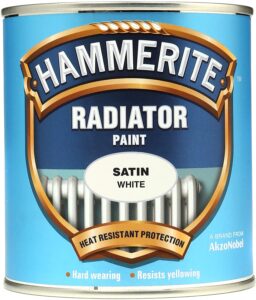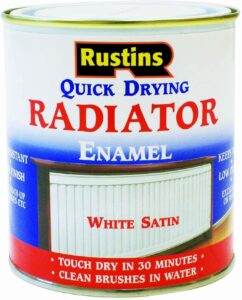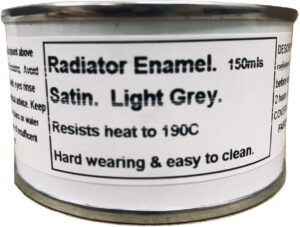
Despite writing this in the middle of a surprisingly warm and humid British summer, where radiators seem about as far from requisite as can be, now is arguably the best time to give them some love and attention. Radiators are the low-key MVPs of the house during the winter. Just think about how good it is to wake up on a cold winter’s morning, only to remember you set the heating to be on by the time you woke up. Or, coming in from the chilly outdoors and being enveloped in the cosy warmth.
All of this romanticising of radiators notwithstanding, they form a big part of our homes nowadays, both figuratively and literally. At a base level, they’re big metal objects on the walls, and how they look can be hugely influential on how the rest of the room looks. A radiator with spots of peeling paint showing the bare metal underneath just comes across as a bit shabby.
Thankfully, specialist radiator paint is not all that hard to find and can be a very simple way to put the finishing touches to a renovated room. However, given that radiators get distinctly hot by nature, you can’t just put any old paint on there, as radiator paints are specially designed with the heat resistance in mind, among other features. So, read on for our summary of the best radiator paints available to buy right now.
| Name | Coverage | Dry Time | Cost |
|---|---|---|---|
| Hammerite Radiator Paint | 7 m2 /l | 6 hours | ££ |
| Rustins Quick Drying Radiator Enamel | 14 m2 /l | 0.5 hours | £££ |
| Johnstone’s Quick Dry Interior Wood & Metal | 15 m2 /l | 2 hours | £ |
| Rust-Oleum Radiator Enamel Spray Paint | 5 m2 /l | 24 hours | ££ |
| Fascinating Finishes Satin Radiator Paint | 7 m2 /l | 2 hours | ££ |
Hammerite Radiator Paint
This fit-for-purpose paint from Hammerite is a high quality and hard-wearing choice for brightening up your radiators. Specially formulated for use on heating, the mid sheen satin white finish is highly heat resistant and will stay white for longer, resisting yellowing. It can even be used on household hot water pipes as well as the radiator itself.
Hammerite specialise in paint for use on metal, and this is no different. The formula of the paint means that while it’s not the quickest to dry – touch dry in around 6 hours and ready for further coats after 16 – it is absolutely a heavy-duty option that will last. The consistency of the paint also makes it very easy to apply, making this a very solid choice for radiator-specific paints.
Pros
- Extra heat resistance
- Doesn’t yellow
- Suitable for pipes
Cons
- Long drying time
- Only one colour
Rustins Quick Drying Radiator Enamel
Just in case it wasn’t clear from the name, Rustins’ radiator enamel is incredibly quick to dry. Achieving touch-dryness in just 30 minutes, it’ll have your radiators spruced up and bright white in no time at all. This is thanks in no small part to the water-based formula of the paint, which allows it to achieve a thinner consistency without sacrificing ease of application. Another benefit of water-based paints are the low odour levels, and this is no exception.
The white satin colour dries to a lovely mid sheen finish, and is highly resistant to yellowing. It’s also got great heat resistance, as it’s designed specifically for radiators (although Rustins specify that it’s not suitable for oil-based heaters) but could also be used for other white goods around the house.
Pros
- Heat resistant
- Doesn’t yellow
- Quick drying
- Low odour
Cons
- Thin consistency
Johnstone’s Quick Dry Interior Wood & Metal
This water-based satin paint with a quick drying formula from Johnstone’s is made with the express intention of making your DIY painting projects quick, easy and quality. This paint is available in 10 different shades, so depending on whether you want the radiator to stand out as more of a statement piece or match the walls, they’ve got you covered. It’s touch dry in a couple of hours maximum, although it’s recommended to leave it a few hours more if you intend to put a second coat on your radiator. Regardless, it’s well-suited for interior metalwork.
The paint’s satin finish puts forward a pleasant mid-sheen, and with a water base leaves the paint easy to clean once it’s dry. So, once your radiator has been painted up it’ll be easier to keep on top of the job down the line. It’s also pretty hard-wearing, ideal for the tough conditions presented by radiators.
Pros
- Easy to clean
- Quick drying
- Hard-wearing
- Good colour selection
Cons
- A little thin
Rust-Oleum Radiator Enamel Spray Paint
Don’t go getting graffiti ideas – this stuff is for radiators only. A specifically designed radiator enamel from Rust-Oleum, this is intended to make radiator painting a bit of an easier process with a steady hand (and a well-ventilated room). Effectively just a shake-and-spray formulation, this is actually a very versatile paint. As well as a naturally high heat resistance, it’s also washable to help maintain the radiators, as well as actively moisture and rust resistant to keep them looking good for longer.
The bright white satin finish, with a pleasant mid sheen, is resistant to yellowing. It’s touch dry in around an hour but may need as much as 24 hours to fully dry – however, Rust-Oleum recommend that for best results, you can apply several coats a few minutes apart. This spray paint also represents pretty solid value for money, with the long life, high quality results and relatively small price tag. The spray paint formulation means that a little goes a long way.
Pros
- Easy to use
- Great finish
- Decent value
- Good heat resistance
- Moisture/rust proof
Cons
- Care needed with fumes
Fascinating Finishes Satin Radiator Paint
An unassuming tin hides a surprisingly capable paint. Fantastic Finishes might not be an especially common name in the world of paints and DIY, but their satin finish radiator paint packs enough more than enough quality. A major selling point is the excellent heat resistance, which goes up to 190°C. So, no matter how hot you like it, this paint can withstand it.
Touch dry in around 2 hours, this aims to remove the need for multiple coats by being a self-priming paint, which combines the base primer layer as well as the top layer of paint. The resultant finish is tough and hard-wearing, with a mid sheen satin finish in an attractive light grey. It’s also easy to apply as well as easy to clean.
Pros
- Attractive finish
- Easy to apply
- High heat resistance
Cons
- Strong fumes
- Small tin
Which Radiator Paint To Go For?
When it comes to painting your radiators, there are a few key qualities to keep your eyes peeled for. High heat resistance is of paramount importance, as well as good adherence to metal, and a long life. With these things in mind, we’ve narrowed it down to give you the best radiator paint bar none, as well as the best value option.
Best Radiator Paint – Perhaps a little left field, but the Rust-Oleum Radiator Enamel Spray Paint is an outstanding choice for radiator paint. It achieves this by being easy to use and providing really high quality results.
Best Value – For the best value for money, Johnstone’s Quick Dry Interior Wood & Metal is the sure choice. With Johnstone’s renowned quality, this versatile interior paint is good for a lot of uses including radiators, and you get a lot of paint for not much money.
Radiator Paint FAQ
How to paint a radiator
First and foremost, make sure the radiator is off and a nearby window is open. Next, thoroughly clean it, using a vacuum cleaner to remove dust from the inside, warm soapy water to clean the surface to be painted, and a long brush to remove any dirt from between the radiator and the wall. Lay something protective down on your flooring, then gently sand the surface of the radiator with alternating high and low grit sandpaper to get rid of surface debris and create an even surface for the paint. Clean any excess dust from the sanding, then prime and paint the radiator with a brush. Make sure you don’t overload the brush with paint, and do long, even strokes. Then, leave to dry for as long as possible (do not turn the radiator on to try speeding up the process).
How to paint behind a radiator
Painting behind a radiator can be very awkward. You can attempt to use a long roller or brush to get in the gap, but ultimately you will struggle to get any further in than around the edges. Removing the radiator is an essential step if you want to do it properly; you may need to drain the radiator, which is a more complex series of steps but will ultimately allow you the best access to the rear of the heater.
How to paint a rusty radiator
The most thorough method to dealing with rusty patches on your radiator involves some coarse grit sandpaper and some time and effort. Sand it thoroughly and use a metal scraper to get all the residue off, then go ahead and apply some radiator paint. Anti-rust primers are available if you’d like an extra layer of protection.
What paint to use on radiators
By and large, as long as a paint is suitable for use on metal (regardless of finish, that’s down to your preference) it can be used on a radiator. Use specialist radiator paint if necessary, which usually comes with superior rust and heat protection.
How to remove paint from radiators
Completely stripping paint from radiators is something that needs to be done thoroughly and with a fair amount of care. Firstly, coarse grit sandpaper is necessary to remove as much paint as possible. Next, apply a good quality paint remover (goggles and gloves are highly recommended!) and leave it for maybe an hour, until the remaining paint has softened and can be scraped off.





